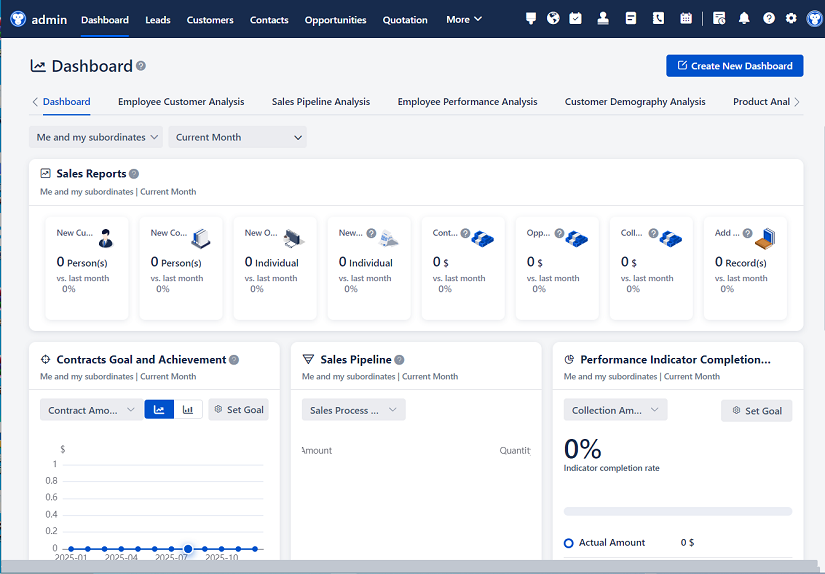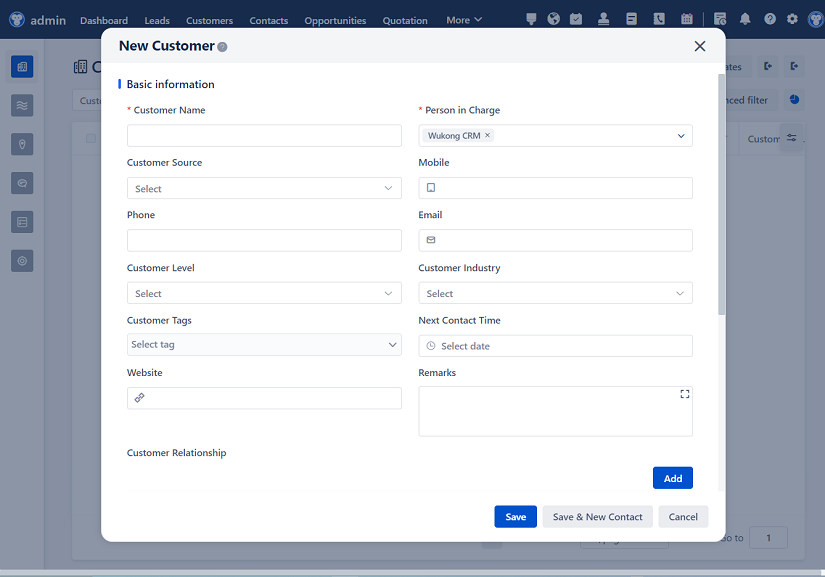
△Click on the top right corner to try Wukong CRM for free
You know, when I first started looking into enterprise-level CRM platforms, I honestly didn’t realize just how much they could actually do. I mean, sure, I knew CRM stood for Customer Relationship Management, but I thought it was mostly about keeping track of contacts and maybe logging a few emails here and there. Boy, was I wrong.
Let me tell you—these systems are way more powerful than that. In fact, if you’re running a mid-sized or large company, not having a solid CRM in place is kind of like trying to drive a race car with no GPS. You might eventually get where you’re going, but you’ll waste so much time, fuel, and energy along the way.
Free use of CRM system: Free CRM

So what exactly makes a CRM “enterprise-level”? Well, from what I’ve seen, it’s not just about scale—it’s about depth, flexibility, integration, and intelligence. These platforms aren’t built for small teams sending out birthday emails. They’re designed for complex organizations with hundreds or even thousands of employees, multiple departments, global operations, and tons of customer data flowing in every second.
One thing I really appreciate about modern enterprise CRMs is how customizable they are. Like, you’re not stuck with some rigid template that forces your sales team to change their workflow. Instead, you can tweak almost everything—fields, dashboards, automation rules, reporting structures—you name it. It’s kind of like building your own house instead of buying a pre-fab one.
And speaking of workflows, have you seen how smooth things can get once everything’s automated? I remember working at a company where our sales reps had to manually enter leads from web forms into the system. Can you believe that? It was such a waste of time, and mistakes happened all the time. But after we implemented an enterprise CRM with smart lead capture and routing, those leads were assigned instantly based on region, product interest, or even past behavior. It was like magic.
Another big win? The analytics. I used to sit through these long meetings where people argued about why sales were down last quarter. Now, with real-time dashboards and predictive insights, we can see trends as they happen. We can spot which campaigns are converting, which regions are underperforming, and even predict customer churn before it happens. It’s not mind reading, but it’s close.
Oh, and don’t even get me started on integration. One of the biggest headaches companies face is having data scattered across different tools—email, marketing platforms, support tickets, ERP systems. But a good enterprise CRM acts like a central hub. It pulls everything together so you’re not constantly switching tabs or guessing what someone else knows.
I remember this one time when a customer called support with a billing issue. Without the CRM, the agent would’ve had to ask for account details, check another system, then call finance. But because everything was synced, the agent saw the full history—past purchases, recent emails, open quotes—all in one screen. They resolved the issue in two minutes. The customer was shocked. Honestly, so was I.
Security is another thing I didn’t think much about at first. But when you’re dealing with enterprise data—personal info, contracts, financial records—you can’t afford to cut corners. Enterprise CRMs come with serious security features: role-based access, audit trails, encryption, compliance with GDPR and CCPA. It gives everyone peace of mind, especially the legal team.
And let’s talk about scalability. Startups might start with a simple tool, but as they grow, they hit limits fast. Enterprise CRMs are built to grow with you. Whether you add 10 new users or expand into three new countries, the system adapts. No need to migrate data or retrain everyone every six months.
User adoption used to be a huge problem, though. I’ve seen companies spend millions on a CRM only to have employees ignore it because it was too clunky. But today’s platforms are way more user-friendly. Clean interfaces, mobile apps, voice commands—some even use AI to suggest next steps. It feels less like work and more like getting help.
AI, by the way, is changing everything. I was skeptical at first—thought it was just buzzword nonsense. But now I see how AI-powered CRMs can analyze customer sentiment in emails, recommend the best time to follow up, or even draft responses. It doesn’t replace humans; it just makes them way more effective.
Collaboration has improved too. Sales, marketing, and service teams used to operate in silos. Marketing would run a campaign, sales would complain they never got good leads, and service would have no idea what was promised. With a shared CRM, everyone sees the same data. Alignment goes way up.
Onboarding new employees is easier now, too. Instead of spending weeks teaching them where to find customer info, we just give them access to the CRM. Everything’s documented—the communication history, deal stages, pricing approvals. They’re productive in days, not months.
Custom reporting is another game-changer. Finance used to beg for sales forecasts every month. Now they log in and pull live reports themselves. No more waiting, no more errors from manual spreadsheets. Everyone gets the data they need, when they need it.
But look, it’s not all perfect. Implementing an enterprise CRM takes time, effort, and money. You can’t just flip a switch and expect miracles. There’s planning, data cleanup, training, change management. I’ve seen projects fail because leadership treated it like a software purchase instead of a business transformation.
That’s why having a clear strategy matters. You’ve got to define your goals: better customer retention? faster sales cycles? improved cross-selling? Once you know what you want, you can configure the CRM to support it.
Vendor choice is important too. Salesforce, Microsoft Dynamics, HubSpot Enterprise, Oracle, SAP—they all have strengths. Some are better for sales-heavy orgs, others for service or marketing. You’ve got to pick one that fits your culture and long-term vision.

And yes, cost is a factor. These platforms aren’t cheap. Licensing, customization, integration, ongoing support—it adds up. But when I look at the ROI, it’s usually worth it. Faster deals, fewer lost customers, better insights—it pays for itself over time.
One thing I love is how mobile these systems have become. I can check my pipeline from the airport, approve a contract from my couch, or get alerts when a key client opens an email. It keeps me connected without being chained to a desk.
Customer experience has definitely improved. With a 360-degree view of each customer, we can personalize interactions like never before. No more calling someone by the wrong name or offering a product they already bought. That stuff kills trust.
Plus, feedback loops are tighter. If a customer complains on social media, the CRM can flag it and route it to the right person. We respond faster, fix issues quicker, and turn unhappy customers into loyal ones.
Training resources have gotten better too. Most vendors offer online courses, certifications, and active user communities. When I had a question about workflow automation, I found a tutorial video in five minutes. No waiting for IT.
Data quality is still a challenge, though. Garbage in, garbage out—they say that for a reason. If your team skips entering notes or uses inconsistent labels, the reports become useless. So ongoing data hygiene is crucial.
But when it’s done right? Man, it’s beautiful. Imagine knowing exactly which customers are most likely to buy, which channels bring the best leads, and which reps need coaching—all in real time. That’s power.
And the best part? It’s not just for sales anymore. HR uses it to track candidate relationships. Marketing uses it for segmentation. Even executives use it to monitor KPIs. It becomes the single source of truth.
I’ll admit, I was skeptical at first. I thought CRMs were just digital Rolodexes. But after living with one for a few years, I can’t imagine running a business without it. It’s like having a co-pilot who knows everything about your customers and helps you make smarter decisions every day.

So if you’re on the fence about upgrading to an enterprise CRM, here’s my advice: do your research, involve your teams early, plan carefully, and commit to using it fully. It’s not a quick fix, but it’s one of the best investments you can make in your customer relationships—and ultimately, your bottom line.
FAQ (Frequently Asked Questions)
Wait, isn’t an enterprise CRM just for big companies?
Not necessarily. While they’re built for scale, many mid-sized businesses benefit too—especially if they’re growing fast or have complex customer processes.
How long does it take to implement one?
It varies, but typically 3 to 9 months. It depends on your size, data complexity, and how much customization you need.
Can it integrate with our existing tools?
Most enterprise CRMs offer hundreds of pre-built integrations with email, ERP, marketing automation, and cloud storage tools. APIs make custom connections possible too.

Will our team actually use it?
User adoption is key. Choose a user-friendly platform, provide training, and show how it makes their jobs easier—not harder.
Is cloud-based or on-premise better?
Cloud is more common now—faster updates, lower maintenance, and accessible from anywhere. On-premise gives more control but requires IT resources.
What about data migration? Is it risky?
It can be, but with proper planning and testing, risks are minimized. Many vendors offer migration tools and support.
Can it help with compliance?
Yes. Features like audit logs, consent tracking, and data encryption help meet GDPR, HIPAA, CCPA, and other regulations.
Do we need consultants to set it up?
Many companies use partners or consultants, especially for complex deployments. But simpler setups can be handled internally.
How do we measure success after implementation?
Track KPIs like sales cycle length, lead conversion rate, customer satisfaction, and time saved on admin tasks.
Can AI really make a difference in CRM?
Absolutely. From predicting churn to automating follow-ups, AI enhances decision-making and efficiency—when used wisely.
Related links:
Free trial of CRM
Understand CRM software

△Click on the top right corner to try Wukong CRM for free